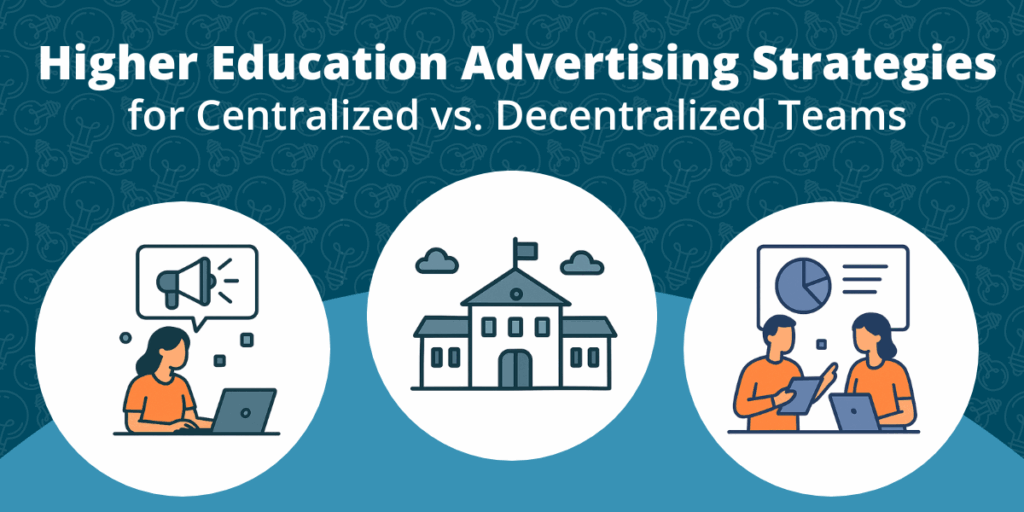Higher Education Advertising Strategies for Centralized vs. Decentralized Teams
September 17th, 2025 by

Key Insights
- Team structure drives advertising performance. A centralized marketing team delivers efficiency and consistency, while decentralized teams excel in agility and program-level targeting.
- Most universities operate in hybrid models. Few are purely centralized or decentralized. Hub-and-spoke and collaborative networks are common, and each impacts paid advertising differently.
- Aligning strategy with structure prevents wasted spend. The right setup helps higher education marketers avoid overlapping ads, mixed messages, and underperforming budgets.
- Paid advertising success comes from clarity. Institutions that match their organizational model to their media strategy see stronger ROI, better audience targeting, and more meaningful enrollment outcomes.
If you’re responsible for higher education advertising at an institution, you already know the challenge.
Every school, program, and department wants visibility, and they all want it yesterday.
Meanwhile, leadership expects a unified brand that builds credibility and delivers enrollment results.
That tension comes to a head in paid campaigns, where budgets are closely watched and wasted spend is difficult to justify.
Should all campaigns be managed by one centralized marketing team to ensure control and consistency? Or should departments run their own ads to tailor messages for specific programs and audiences?
Most institutions operate somewhere in between. Knowing where your structure falls (e.g, centralized, decentralized, or hybrid) is the first step toward building a digital advertising strategy that makes every dollar work harder.
Variations in Centralized and Decentralized Higher Education Advertising
Not all universities fit neatly into “fully centralized” or “fully decentralized.” Recognizing your model is key to avoiding wasted budget and reaching the right students.
Centralized Variations
Centralized structures are common when leadership wants control, efficiency, and a unified voice. Within this approach, there are two main models institutions typically follow:
Fully centralized
In this model, one marketing office controls all budgets, creative, targeting, and reporting. Paid campaigns for undergraduate admissions, graduate programs, and brand-building all flow through the same team. This creates consistency and accountability, but campaigns often move more slowly, and programs with niche audiences may feel underserved.
Hub-and-spoke
With a “hub-and-spoke” setup, the central office sets strategy and creative standards, and likely also provides already-approved ad templates. The departments then execute campaigns within those guidelines.
For example, a nursing school might adapt central paid search templates to highlight clinical outcomes, while the business school uses the same framework to promote MBA career paths. This model gives programs flexibility without losing alignment, but it requires clear governance to work well.
Decentralized Variations
Decentralized structures give schools more autonomy and agility. Instead of waiting for central approval, departments can quickly tailor campaigns to their audiences. Two common models fall under this approach:
Fully independent
In a fully independent model, each school or department manages its own advertising, from budgets to creative to targeting. For example, the business school might run a Meta campaign to boost MBA enrollment, while engineering launches LinkedIn ads for prospective undergraduates.
This setup gives programs agility and control over their own messaging, but it often leads to inconsistent brand voice, overlapping campaigns, and higher costs when departments compete for the same prospective students.
Collaborative network
In a collaborative network, departments run their own campaigns but share certain resources, such as analytics platforms, vendor contracts, or a CRM. For example, multiple schools may use a shared DSP to buy media while still creating their own ads.
This structure lowers costs and improves visibility across programs, but it depends on adoption. Without consistent use of shared tools, you can still end up with inefficiencies and fragmented audience targeting.
Pros and Cons of Each Structure
Centralized Structure
A centralized marketing team shines when leadership prioritizes consistency and efficiency. But in practice, it can also create friction when programs need specialized campaigns.
Pros
- Cohesive brand identity: Every ad, across search, social media, and display, reinforces a unified message for prospective students.
- Economies of scale: Media dollars go further when a centralized marketing team buys in bulk, lowering CPCs and CPMs.
- Clear reporting: Centralized audience data makes it easier to connect campaigns to enrollment outcomes.
- Policy alignment: There’s easier institute-wide compliance with accessibility, privacy, and government regulations.
Cons
- Slower response times: Campaigns for specific academic programs or niche demographics may lag.
- Creative bottlenecks: One team reviewing all assets can delay launches.
- Departmental disconnect: Faculty and program chairs may feel their priorities aren’t represented.
Decentralized Structure
Decentralized models work best when agility matters most, but that same autonomy often leads to inefficiency and fragmentation in higher education campaigns.
Pros
- Agility: Departments can launch or pivot enrollment marketing campaigns quickly.
- Tailored messaging: Schools can highlight unique career outcomes, campus life, and student success stories.
- Encourages innovation: Independent teams are often able to test new tools, channels, or creative approaches.
Cons
- Brand inconsistency: Prospective students may see conflicting messages across multiple channels.
- Budget inefficiency: Overlapping campaigns may compete for the same target audience.
- Limited ROI visibility: Multiple CRMs or landing pages can make performance tracking difficult.
Paid Ad Strategies for Each Structure in Higher Education
Understanding your structure is only useful if it translates into smarter campaigns. Each model requires a different approach to ensure your ad dollars are invested wisely and drive enrollment.
For Fully Centralized Teams
When one marketing office owns all advertising, scale and consistency are your biggest advantages. The challenge is making sure campaigns still connect with prospective students across different programs.
- Plan around the calendar: Create a campaign roadmap that aligns with enrollment cycles, campus events, and application deadlines. This ensures steady awareness throughout the year.
- Leverage remarketing: Use centralized retargeting to reach visitors across all university web pages, reinforcing brand visibility and creating a unified experience for potential students.
- Allocate budgets strategically: Prioritize spend where it aligns with enrollment goals, career outcomes, and high-demand academic programs, not just where the loudest requests come from.
For Hub-and-Spoke Models
This hybrid structure allows departments to highlight their strengths while the central office maintains control of strategy. It works best when there’s clear communication and shared insights.
- Distribute audience research: Share data on audience behaviors and search insights to help schools tailor campaigns to the right demographics.
- Provide creative frameworks: Branded ad templates and pre-approved copy blocks let departments develop authentic content that still feels consistent.
- Centralize reporting: A shared dashboard helps leaders and departments monitor engagement, compare performance, and refine higher education marketing strategies.
For Fully Independent Departments
When every college runs its own campaigns, speed and specialization come naturally. The risk to avoid, however, is waste, including duplicate targeting, inconsistent messaging, and missed opportunities for collaboration.
- Hold quarterly ad reviews: Bring departments together to compare results, share key strategies, and reduce overlap.
- Encourage light-touch brand guidelines: Even voluntary frameworks help create a more unified experience for prospective students.
- Pool funds for high-cost media: Channels like YouTube, CTV, or sponsored content often deliver deeper connections with specific demographics but may be out of reach for one department’s budget alone.
For Collaborative Networks
A collaborative network provides autonomy but relies on shared resources to cut costs and increase efficiency. The success of this model depends on adoption across departments.
- Invest in shared platforms: A common CRM or analytics system makes it easier to track engagement and communications across the institution.
- Coordinate retargeting pixels: Prevent schools from competing for the same audiences online by unifying tracking.
- Offer training: Equip decentralized teams with the skills to interpret insights and use digital marketing tools effectively.
How to Decide Which Model Works for Your Institution
Choosing between centralized vs decentralized marketing structures isn’t about which one is “better.” It’s about which one matches your institution’s size, resources, and enrollment goals.
A small liberal arts college with a handful of academic programs may thrive under a centralized marketing team, while a large research university with multiple colleges often needs hybrid structures to balance control and autonomy.
Key factors to consider include:
- Number of schools and programs: The more academic programs you offer, the harder it becomes for one office to manage every campaign.
- Central marketing staff size: If your team is lean, decentralized departments may need more responsibility.
- Technology and infrastructure: Institutions with robust CRMs, shared analytics, and advanced digital marketing tools can unify campaigns more easily.
- Leadership priorities: Some universities value a unified experience and brand voice above all. Others prefer program-level autonomy to reach specific demographics.
- Hybrid effectiveness: Many higher education institutions succeed with hub-and-spoke or collaborative models, where central offices provide guidance and resources while departments tailor ads for their own prospective students.
The right fit comes down to aligning your organizational design with your advertising goals.
Common Challenges in Higher Ed Paid Ad Management
Even with a well-chosen model, challenges are inevitable. Higher education advertising is complex, with multiple audiences, competing priorities, and budget pressures. Some of the most common issues include:
- Budget allocation disputes: Programs often compete for limited funds, leading to tension over who gets priority.
- Duplicated targeting: Without coordination, two departments may spend against the same prospective student audience in major search engines or social media platforms.
- Fragmented tracking: Multiple CRMs, landing pages, or disconnected web pages make it difficult to attribute campaigns back to enrollment outcomes.
- Compliance requirements: Accessibility standards, privacy regulations, and institutional diversity goals must all be reflected in campaigns.
- Balancing consistency with flexibility: Universities need cohesive brand visibility, but also space for departments to highlight authentic content such as student success stories, career outcomes, and campus life.
Addressing these challenges requires more than good intentions. It takes shared governance, modern tools, and clear reporting structures.
How an Advertising Agency Can Bridge the Gap
Many institutions find that bringing in an external partner helps them balance competing needs. An experienced higher education advertising agency acts as both strategist and coordinator, offering:
- Cross-department coordination: Ensuring enrollment marketing campaigns complement, rather than compete with, each other.
- Centralized analytics: A unified view of performance across digital marketing channels, from paid search to sponsored content.
- Audience research: Fresh insights into audience behaviors, college options, and what drives potential students to engage.
- Budget optimization: Redirecting spend toward the channels and creative that attract more students and deliver ROI.
- Neutral facilitation: Acting as a “traffic controller” to balance requests from different colleges and departments.
The right partner doesn’t take control away from internal teams. It creates alignment, so every program benefits from a smarter strategy and cleaner execution.
FAQs About Centralized vs. Decentralized Marketing Strategies
How does team structure impact higher education advertising strategies?
Structure determines who controls budgets, creative, and targeting. Centralized teams create consistent messaging, while decentralized teams allow program-level customization. Hybrid structures aim to capture the benefits of both.
What KPIs should universities prioritize in paid ad campaigns, regardless of structure?
Metrics like cost per inquiry, cost per enrollment, website engagement, and conversion rates from landing pages tie directly to marketing goals. These help link advertising dollars to measurable enrollment outcomes.
How do you measure ROI across multiple departments?
Shared CRMs, attribution models, and centralized dashboards allow institutions to consolidate insights. Without these, it’s nearly impossible to connect spending with results across multiple academic programs.
How can universities prevent brand inconsistency in decentralized campaigns?
Use creative frameworks like branded templates, approved copy blocks, and optional reviews. This allows departments to create authentic content while maintaining a consistent look and feel.
Is it better to manage university paid media internally or with an external agency?
It depends on your resources. Internal teams know the culture and campus life deeply, while agencies bring advanced tools, digital marketing expertise, and broader insights. Many educational institutions benefit from a hybrid approach (internal vision with external execution support).
Digital Advertising for Higher Education: Smarter Ad Spending Starts With Structure
The structure of your marketing team is one of the biggest factors in the success of your higher education advertising.
No model is “right” or “wrong” on its own. The key is aligning your digital advertising strategy with how your institution actually operates. When structure and strategy match, you avoid wasted budget, reduce audience overlap, and deliver a unified experience for prospective students.
Download the ROI White Paper
At Search Influence, we’ve seen firsthand how much team structure impacts campaign performance. That’s why we developed “3 ROI Models to Prove the Value of Your Education Marketing,” a practical guide to help higher education institutions measure and improve the impact of their digital advertising.
In the white paper, we share:
- Three proven models for evaluating higher education marketing campaigns
- How to turn data and insights into smarter, faster decision-making
- Tips for preparing confident conversations with leadership and stakeholders
- Strategies to refine campaigns in real time to attract more students and strengthen ROI
Don’t wait until the next enrollment cycle to maximize your ad spend. Download our ROI white paper today and start building a more measurable, effective advertising strategy tailored to your institution.



